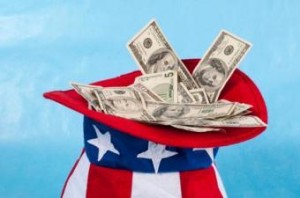 [1]In light of the substantial decline in profitability of both Fannie Mae [2] and Freddie Mac [3] for 2014, Urban Institute [4] senior fellow Jim Parrott, a former economic adviser to President Obama, examined the likelihood of Freddie Mac making another draw from the U.S. Department of Treasury [5] in a research brief published Monday [6] entitled "What to Make of the Dramatic Fall in GSE Profits."
[1]In light of the substantial decline in profitability of both Fannie Mae [2] and Freddie Mac [3] for 2014, Urban Institute [4] senior fellow Jim Parrott, a former economic adviser to President Obama, examined the likelihood of Freddie Mac making another draw from the U.S. Department of Treasury [5] in a research brief published Monday [6] entitled "What to Make of the Dramatic Fall in GSE Profits."
A hugely profitable year in 2013 for both Fannie Mae ($84 billion) and Freddie Mac ($49 billion) shifted widespread speculation from winding down the two GSEs to instead ending FHFA [7]'s conservatorship of the two Enterprises, which began in September 2008 after the two received a combined $188 billion from Treasury in bailout funds.
The 2014 profits for the GSEs, however, fell way short of their 2013 numbers ($14 billion for Fannie Mae and $8 billion for Freddie Mac), including a 90 percent year-over-year decline in profits for Freddie Mac during the fourth quarter of 2014.
When the losses for the GSEs exceed their capital buffer – which is $1.8 billion for 2015 – the Enterprises would require a draw from Treasury, which they have avoided since 2012 (in 2012, the terms of the 2008 bailout agreement were amended, and since then nearly all GSE profits have been swept into Treasury). The GSEs' capital buffer is being reduced by $600 million per year until it is extinguished completely in 2018.
The reason for the loss in profits for both institutions is that much of their revenue streams in 2013 were largely disappearing, according to Parrott. About half of the profits for both Enterprises that year came from reclaiming written-down tax assets ($45 billion for Fannie Mae and $23 billion for Freddie Mac); between a quarter and a third of the profits came from their portfolios ($19 billion for Fannie Mae and $16 billion for Freddie Mac), and each received a significant sum from legal settlements, though it is difficult to determine exactly how much due to the dispersement of the settlement funds among larger revenue streams.
"The only major revenue source not being wound down is what the GSEs generate from their core guarantee business, in which they collect a fee in exchange for guaranteeing the default risk of loans for investors," Parrott wrote.
The primary source of profits for the GSEs in 2014 came from guarantee fees - $9 billion out of $14 billion for Fannie Mae and $4 billion out of $8 billion for Freddie Mac.
Parrott says he believes that it is unlikely Freddie Mac will need to make a draw on Treasury for three reasons: first, he expects Freddie Mac's accounting losses on its derivative position to reverse as interest rates rise; second, Parrott said Freddie Mac's portfolio will still be significant for the next couple of years; and third, Freddie Mac's older loans with lower guarantee fees will gradually be replaced with new loans that have higher guarantee fees, which will result in an increase in revenue.
But while he said he does not believe Freddie Mac will require a draw in the immediate future, that may change a couple of years down the road.
"When the private-label securities market finally comes back and Freddie’s market share decreases, so will the revenue from its guarantee business," Parrott wrote. "And if Freddie finally opens up its credit box, Freddie will expose itself to more risk and, depending on how well it prices that risk, more volatility in its earnings. No longer able to counter losses in this business with gains on its portfolio investments, Freddie becomes increasingly exposed to changes in the economic environment. In short, Freddie’s risk of a draw goes up."
Freddie Mac has a $140 billion line of credit with Treasury, however, so if the Enterprise did require a draw, "substantively, not much" would happen in the immediate future, Parrott wrote. However, investors will begin to demand a discount to cover the risk should Freddie Mac's draw eventually exceed the line of credit amount.
